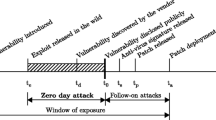Abstract
Securing critical infrastructure, particularly nuclear power plants, against emerging cyber threats necessitates innovative cybersecurity approaches. This research introduces FusionGuard, a hybrid machine learning-based anomaly detection system designed for early warnings of ransomware and spyware intrusions within nuclear power plant systems. Meticulously tailored to the unique characteristics of nuclear power plant networks, FusionGuard leverages diverse datasets encompassing normal operational behavior and historical threat data. Through cutting-edge machine learning algorithms, the system dynamically adapts to the network's baseline behavior, effectively identifying deviations indicative of ransomware or spyware activities. Rigorous experimentation and validation using real-world data and simulated attack scenarios affirm FusionGuard's proficiency in detecting anomalous behavior with remarkable accuracy and minimal false positives. The research also explores the system's scalability and adaptability to evolving attack vectors, fortifying the cybersecurity posture of nuclear power plant systems in a dynamic threat landscape. In summary, FusionGuard promises to fortify the security of nuclear power plant systems against ransomware and spyware threats by capitalizing on machine learning and anomaly detection. Serving as a sentinel, the system issues timely alerts and enables proactive responses, contributing substantively to the ongoing discourse on protecting essential systems in high-stakes environments.













Similar content being viewed by others
Data availability
The author used data to support the findings of this study that is included in this article.
References
Peng, J., Chen, X., Li, M., Zhang, Y.: Torque anomaly detection of nuclear power electric valve actuator based on DAE-WDSVVD. J. Phys. Conf. Ser. (2022). https://doi.org/10.1088/1742-6596/2187/1/012048
Farber, J. et al.: Process anomaly detection for sparsely labeled events in nuclear power plants. Idaho Natl. Lab. Extern. Rep., no. September 2021 (2021)
Subekti, M.: The improvement of neuro-expert method for anomaly the improvement of neuro-expert method for anomaly detection in nuclear reactor (2015)
“PhD_Schoonewelle.pdf.”
Ibrahim, M., Alsheikh, A., Awaysheh, F.M., Alshehri, M.D.: Machine learning schemes for anomaly detection in solar power plants. Energies 15(3), 1–17 (2022). https://doi.org/10.3390/en15031082
Katser, I., Raspopov, D., Kozitsin, V., Mezhov, M.: Machine learning methods for anomaly detection in nuclear power plant power transformers (2022). http://arxiv.org/abs/2211.11013
Kollias, S., et al.: Machine learning for analysis of real nuclear plant data in the frequency domain. Ann. Nucl. Energy 177, 109293 (2022). https://doi.org/10.1016/j.anucene.2022.109293
Water, L., Sustainability, R.: Light water reactor sustainability program subtle process-anomalies detection using machine-learning methods (2019)
Ioannou, G., Tagaris, T., Alexandridis, G., Stafylopatis, A.: Intelligent techniques for anomaly detection in nuclear reactors. Int. Conf. Phys. React. Transit. to a Scalable Nucl. Futur. PHYSOR 2020, vol. 2020-March, pp. 2972–2979 (2020). https://doi.org/10.1051/epjconf/202124721011
Lee, K., Lee, J., Yim, K.: Classification and analysis of malicious code detection techniques based on the APT attack. Appl. Sci. (2023). https://doi.org/10.3390/app13052894
Å. Ô. Êô, Ô. Á. Ëòçô, and Â. Âòåñ, “ÅÔ ¢ ÊÔ · ¸ Ô ì Á ËÒÇÔ · ÂÒÅÑ Â àaÕ Â § ãËÁè Copyright © by,” no. August, p. 2711 (2006)
Sjögren, S.: Anomaly detection with machine learning (2023)
Memory, L.S., Autoencoder, B.: Anomaly detection of power plant equipment using (2020)
Jin, X., Guo, Y., Sarkar, S., Ray, A., Edwards, R.M.: Anomaly detection in nuclear power plants via symbolic dynamic filtering. IEEE Trans. Nucl. Sci. 58(1 Part 2), 277–288 (2011). https://doi.org/10.1109/TNS.2010.2088138
Maurya, C.K., Toshniwal, D.: Anomaly detection in nuclear power plant data using support vector data description. IEEE TechSym 2014 - 2014 IEEE Students’ Technol. Symp., pp. 82–86 (2014). https://doi.org/10.1109/TechSym.2014.6807919
DeMedeiros, K., Hendawi, A., Alvarez, M.: A survey of AI-based anomaly detection in IoT and sensor networks. Sensors (2023). https://doi.org/10.3390/s23031352
Huang, Q., et al.: A review of the application of artificial intelligence to nuclear reactors: Where we are and what’s next. Heliyon 9(3), e13883 (2023). https://doi.org/10.1016/j.heliyon.2023.e13883
Calivá, F., et al.: A deep learning approach to anomaly detection in nuclear reactors. Proc. Int. Jt. Conf. Neural Netw. 2018, 4137–4144 (2018). https://doi.org/10.1109/IJCNN.2018.8489130
Talaei Khoei, T., Kaabouch, N.: A comparative analysis of supervised and unsupervised models for detecting attacks on the intrusion detection systems. Information (2023). https://doi.org/10.3390/info14020103
Calivá, F., et al.: A deep learning approach to anomaly detection in nuclear reactors. Proc. Int. Jt. Conf. Neural Netw. (2018). https://doi.org/10.1109/IJCNN.2018.8489130
Funding
This work was supported and funded by the Deanship of Scientific Research at Imam Mohammad Ibn Saud Islamic University (IMSIU) (Grant Number # IMSIU-RG23072).
Author information
Authors and Affiliations
Contributions
Conceptualization: AHNA. Methodology: AHNA. Software: AHNA. Formal analysis: AHNA. Resources: AHNA. Writing—review and editing: AHNA. Funding acquisition: AHNA.
Corresponding author
Ethics declarations
Conflict of interest
The author declares no conflict of interest. “I confirm that I am the only Solo/Single author of this research manuscript, and the above-mentioned funding (Grant Number # IMSIU-RG23072) is the faculty research grant to support/finance the publication fee (APC)”.
Additional information
Publisher's Note
Springer Nature remains neutral with regard to jurisdictional claims in published maps and institutional affiliations.
Rights and permissions
Springer Nature or its licensor (e.g. a society or other partner) holds exclusive rights to this article under a publishing agreement with the author(s) or other rightsholder(s); author self-archiving of the accepted manuscript version of this article is solely governed by the terms of such publishing agreement and applicable law.
About this article
Cite this article
Almoqbil, A.H.N. Anomaly detection for early ransomware and spyware warning in nuclear power plant systems based on FusionGuard. Int. J. Inf. Secur. (2024). https://doi.org/10.1007/s10207-024-00841-z
Accepted:
Published:
DOI: https://doi.org/10.1007/s10207-024-00841-z




